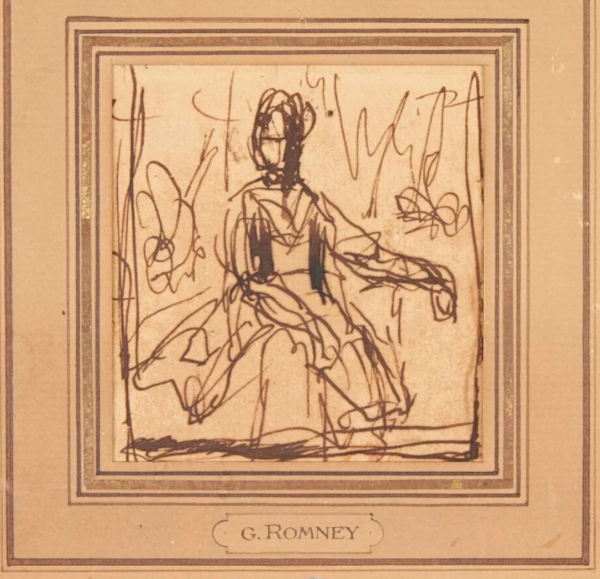
.
.
.
#TrashToTreasure #GeorgeRomney #DumpsterDiscovery #ArtNetFind #HudsonNY #AntiqueSketch #18thCenturyArt #ArtAuction #RomneyArt #HistoricalArt #ArtCollector #FrickCollection #ArtJourney #ArtHistory #WorthPoint
In a story that perfectly encapsulates the saying “one person’s trash is another person’s treasure,” a sketch by the renowned 18th-century English portraitist George Romney was recently discovered in a dumpster in Hudson, New York. The sketch, believed to be nearly 300 years old, was found by an anonymous dumpster diver who initially had no idea of its historical significance. “When I first found it buried in the dumpster, it looked interesting, but I had no idea it was nearly 300 years old,” the individual said. After conducting research, the dumpster diver identified the sketch as the work of Romney, marked with the artist’s studio stamp and labeled “G. Romney.” The artwork depicts Henrietta Greville, the Countess of Warwick, and is thought to be a preliminary sketch for a portrait Romney completed in the 1780s, which is now part of the Frick Collection in New York, less than 200 miles from where the sketch was found.
The sketch’s journey from a dumpster to auction is nothing short of extraordinary. It was eventually put up for auction and sold on March 12, 2025, to a private collector in Malaysia for $3,055—a price well above initial estimates. An auction house spokesperson remarked on the sketch’s remarkable story, stating, “Despite its modest size, this work on paper achieved a price well above estimate, reflecting both its art-historical importance and its extraordinary story.” The sale highlights the sketch’s dual appeal: its artistic significance and the intriguing tale of its discovery.
George Romney was one of the leading portrait painters in 18th-century England, and his works are prominently featured in international collections, including the Metropolitan Museum of Art, the Art Institute of Chicago, the National Gallery of Art, the Philadelphia Museum of Art, and The Getty. The WorthPoint Price Guide lists nearly 300 examples of his artwork, underscoring his enduring influence and the value placed on his creations. This sketch, though modest in size, is a testament to Romney’s skill and the timeless allure of his work.
The story of its discovery also raises questions about how such a historically significant piece ended up in a dumpster. While the exact circumstances remain unknown, speculation abounds. Could it have been discarded by someone unaware of its value, or was it part of a larger collection that was carelessly disposed of? Regardless of its origins, the sketch’s rediscovery and subsequent sale serve as a reminder of the importance of preserving art and the potential for hidden treasures in the most unexpected places.
The dumpster diver who found the sketch exemplifies the serendipitous nature of such discoveries. Their curiosity and willingness to investigate the sketch’s origins led to the identification of a valuable piece of art history. This story also highlights the role of research in uncovering the true worth of seemingly insignificant items. By delving into the sketch’s background, the dumpster diver was able to connect it to Romney’s larger body of work and its place in art history.
The auction of the sketch not only brought financial reward but also renewed interest in Romney’s legacy. His portraits, known for their elegance and psychological depth, continue to captivate audiences centuries after their creation. The sketch of Henrietta Greville, the Countess of Warwick, offers a glimpse into Romney’s creative process and the preliminary work that went into his finished portraits. Its sale to a private collector ensures its preservation, though questions remain about whether it will eventually be displayed publicly or remain in private hands.
This discovery also underscores the broader cultural and historical significance of art. Artworks like Romney’s sketch are not just valuable for their aesthetic qualities but also for the stories they tell and the insights they provide into the past. The sketch’s journey from an 18th-century studio to a 21st-century dumpster and then to an auction house is a testament to the enduring power of art to transcend time and place.
In conclusion, the story of the George Romney sketch found in a dumpster in Hudson, New York, is a fascinating tale of discovery, research, and preservation. It highlights the importance of recognizing the value of seemingly insignificant objects and the role of curiosity in uncovering hidden treasures. The sketch’s sale to a private collector ensures its continued preservation, while its remarkable story adds a new chapter to the legacy of George Romney, one of England’s most celebrated portraitists. This discovery serves as a reminder that art, history, and value can often be found in the most unexpected places.
Source link


